My Experience of Building a Cat Run
Living with cats, I know the long standing debate; indoor or outdoor? Whilst my cats are indoor, I wanted to give them the freedom to enjoy the outdoors as well. Therefore creating a safe cat run become an essential part of my home and garden. Once the decision was made, we needed to take several aspects into consideration; where would it be, who would use it and how would it be used? For instance, if we were building an exercise run we would want this to be adjacent to our house so easily accessed by the cats, however, for a stud run, building a secure and comfortable living quarters would be of greater importance. Although already committed to the idea of a run, the arrival of our new kitten who would grow up to be our stud boy, sealed the deal.
Where to Build a Cat Run?
After looking at commercially produced cat runs, we felt that we could build our own cat run and by doing so, make it suit our needs perfectly and save a considerable amount of money. We chose an area of our garden that was enclosed on three sides by wall with the advantages of being an easily penned in area that was secure and shielded from the wind. As we would only need to mesh one side and the roof, we made an instant saving on materials. Additionally the pen was overlooked by our kitchen window so that we could choose to allow the cats free access whilst keeping a close eye on them. This has been invaluable for allowing my boy to become accustomed to his run, and whilst he is a kitten, my other cats have enjoyed the free access via the window to the outdoors.
Building the Cat Run
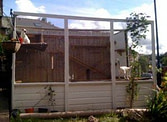 For the frame we used 3×2 inch tantalized timber to create panels about a metre wide and two metres high, although the dimensions will depend on the size of your mesh sheets. A strong one inch welded metal mesh was stretched across the panels and stapled into place. These mesh sheets were easily available from garden and building centres and it is worth spending money here to ensure your mesh is of good quality, strong and galvanised for outside use as it is the one thing that will keep your cat safe inside the enclosure. If other cats access your garden, sneeze barriers can be installed to prevent the spread of infections. These are timber or perspex panels rising approximately two to three foot from the ground around the base of your run.
For the frame we used 3×2 inch tantalized timber to create panels about a metre wide and two metres high, although the dimensions will depend on the size of your mesh sheets. A strong one inch welded metal mesh was stretched across the panels and stapled into place. These mesh sheets were easily available from garden and building centres and it is worth spending money here to ensure your mesh is of good quality, strong and galvanised for outside use as it is the one thing that will keep your cat safe inside the enclosure. If other cats access your garden, sneeze barriers can be installed to prevent the spread of infections. These are timber or perspex panels rising approximately two to three foot from the ground around the base of your run.
Paving stones, grass or concrete all make good surfaces for the run. Cats enjoy grass but it will need regular maintenance whereas paving stones or concrete have the advantage of being easily cleaned.
In our run, the ground was very uneven concrete so we decided to create a nicer surface and storage area in one by installing a decked base. Using pressure treated decking boards we built a raised base with doors in the front to store cat litter, transport boxes and other odds and ends underneath. When building with decking, boards must be positioned approximately a screw’s width apart to allow for expansion. This is fine for an exercise area, however 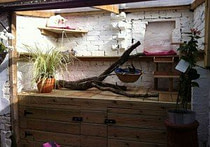
The roof is covered half in mesh and the other half in transparent perspex to create a sheltered area for all weathers as well as an open air area. To ensure good drainage, we sloped the perspex roof down so water could run off it into a gutter that stretched the length of the cat run and fed into a drain. Finally we created a gate from timber and mesh with a padlock on each side meaning we could keep the cats secure and lock the door behind us from inside the run.
The Cat House
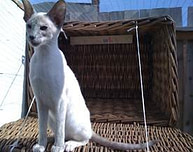
Building Your Own Cat House
In the past we have built our own house using a small shelter raised on legs design. This was built around a frame approximately two metres long by one metre wide. Legs were an intrinsic part of the design, raising the house off the ground by a metre and becoming part of the frame of the house to give it a metre of hight inside the house. The frame was built out of 3×2 inch treated timber creating a strong structure to build our house around. For a simple structure that is sufficient for summer daytime napping, you could simply encase the sides and bottom of the frame in timber. However insulation is simple and will create a warm, draft free napping area for your cats. Between the frame struts we placed Kingspan thermal insulation, or a cheaper option is rockwool insulation; both are available from DIY stores. The outside was clad in timber and the inside was clad in marine plywood or white plastic sided plywood sandwiching the insulation. The front was covered in a perspex sheet for a window for cats to watch the world go by. A timber door with cat flap was installed and a shelf ran underneath the door for the cats to jump on to go in and out. Finally the roof was created from marine plywood covered in roofing felt. The roof was installed sloping backwards and overhung by a couple of inches to ensure water ran away from the house.
Buying a Cat House
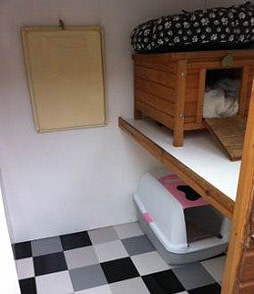
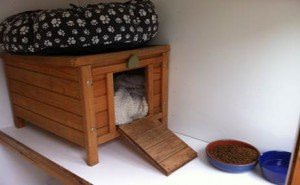
Once you have created a safe and comfortable outdoor area for your cats, the fun part is decorating it and adding the outdoor cat furniture!


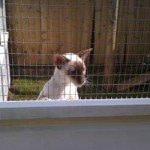
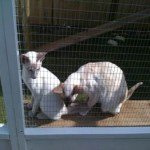

Cannot top that!!! Awesome article… well done Jo xx Good to see Flutterby Ricochet taking pride of place in his kingdom
Thanks Pina, we wanted to make him a super home and Rio loves it!
Wow, that is some cat run, well done, it’s brilliant, I loved reading how you built it, you must have put lots of hard work and many hours into building it but so worth it, your cats look very happy in their new run.
Yes I also really enjoyed this article. I will be publishing the next installment to this article very soon. The next article from Jo is all about furnishing the cat run with toys, scratching posts and cat trees. Another fantastic article which I know you will all enjoy as much as I have.
Thank you for the kind comments. I really enjoyed building the cat run but not as much as I have enjoyed watching the cats use and enjoy it. It was a simple weekend project and the cats have used it every day since, often sitting on the window sill waiting for me to open up each morning. If anyone has any ideas or suggestions for cat runs or photos of their own, I would love to see them shared.